Machine Learning - Decision Tree
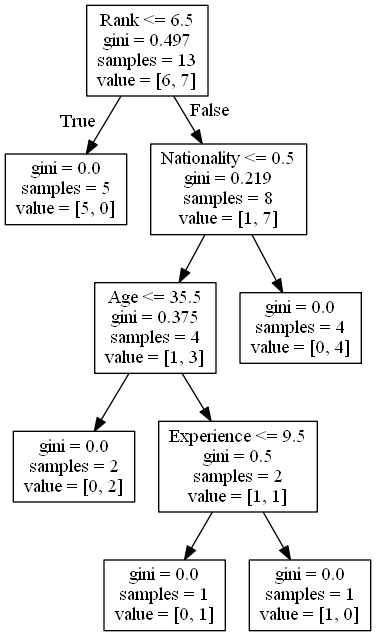
Decision Tree
In this chapter we will show you how to make a "Decision Tree". A Decision Tree is a Flow Chart, and can help you make decisions based on previous experience.
In the example, a person will try to decide if he/she should go to a comedy show or not.
Luckily our example person has registered every time there was a comedy show in town, and registered some information about the comedian, and also registered if he/she went or not.
| Age | Experience | Rank | Nationality | Go |
| 36 | 10 | 9 | UK | NO |
| 42 | 12 | 4 | USA | NO |
| 23 | 4 | 6 | N | NO |
| 52 | 4 | 4 | USA | NO |
| 43 | 21 | 8 | USA | YES |
| 44 | 14 | 5 | UK | NO |
| 66 | 3 | 7 | N | YES |
| 35 | 14 | 9 | UK | YES |
| 52 | 13 | 7 | N | YES |
| 35 | 5 | 9 | N | YES |
| 24 | 3 | 5 | USA | NO |
| 18 | 3 | 7 | UK | YES |
| 45 | 9 | 9 | UK | YES |
Now, based on this data set, Python can create a decision tree that can be used to decide if any new shows are worth attending to.
How Does it Work?
First, read the dataset with pandas:
Example
Read and print the data set:
import pandas
df = pandas.read_csv("data.csv")
print(df)
To make a decision tree, all data has to be numerical.
We have to convert the non numerical columns 'Nationality' and 'Go' into numerical values.
Pandas has a map() method that takes a dictionary with information on how to
convert the values.
{'UK': 0, 'USA': 1, 'N': 2}
Means convert the values 'UK' to 0, 'USA' to 1, and 'N' to 2.
Example
Change string values into numerical values:
d = {'UK': 0,
'USA': 1, 'N': 2}
df['Nationality'] = df['Nationality'].map(d)
d =
{'YES': 1, 'NO': 0}
df['Go'] = df['Go'].map(d)
print(df)
Then we have to separate the feature columns from the target column.
The feature columns are the columns that we try to predict from, and the target column is the column with the values we try to predict.
Example
X is the feature columns,
y is the target column:
features = ['Age', 'Experience', 'Rank', 'Nationality']
X = df[features]
y = df['Go']
print(X)
print(y)
Now we can create the actual decision tree, fit it with our details. Start by importing the modules we need:
Example
Create and display a Decision Tree:
import pandas
from sklearn import tree
from sklearn.tree import
DecisionTreeClassifier
import matplotlib.pyplot as plt
df =
pandas.read_csv("data.csv")
d = {'UK': 0, 'USA': 1, 'N': 2}
df['Nationality']
= df['Nationality'].map(d)
d = {'YES': 1, 'NO': 0}
df['Go'] = df['Go'].map(d)
features = ['Age', 'Experience', 'Rank', 'Nationality']
X = df[features]
y = df['Go']
dtree = DecisionTreeClassifier()
dtree = dtree.fit(X,
y)
tree.plot_tree(dtree, feature_names=features)
Result Explained
The decision tree uses your earlier decisions to calculate the odds for you to wanting to go see a comedian or not.
Let us read the different aspects of the decision tree:
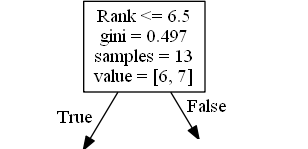
Rank
Rank <= 6.5 means that every comedian with a rank of 6.5 or
lower will follow the
True arrow (to the left), and the rest will
follow the False arrow (to the right).
gini = 0.497 refers to the quality of the
split, and is always a number between 0.0 and 0.5, where 0.0 would mean all of
the samples got the same result, and 0.5 would mean that the split is done
exactly in the middle.
samples = 13 means that there are 13
comedians left at this point in the decision, which is all of them since this is
the first step.
value = [6, 7] means that of these 13
comedians, 6 will get a "NO", and 7 will get a
"GO".
Gini
There are many ways to split the samples, we use the GINI method in this tutorial.
The Gini method uses this formula:
Gini = 1 - (x/n)2 - (y/n)2
Where x is the number of positive answers("GO"),
n is the number of samples, and
y is the number of negative answers ("NO"),
which gives us this calculation:
1 - (7 / 13)2 - (6 / 13)2 = 0.497
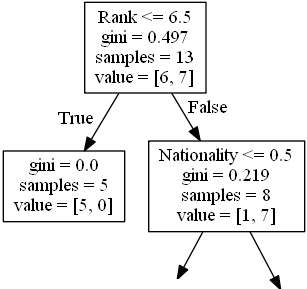
The next step contains two boxes, one box for the comedians with a 'Rank' of 6.5 or lower, and one box with the rest.
True - 5 Comedians End Here:
gini = 0.0 means all of the samples got the
same result.
samples = 5 means that there are 5 comedians
left in this branch (5 comedian with a Rank of 6.5 or lower).
value = [5, 0] means that 5 will get a "NO"
and 0 will get a "GO".
False - 8 Comedians Continue:
Nationality
Nationality <= 0.5 means that the comedians
with a nationality value of less than 0.5 will follow the arrow to the left
(which means everyone from the UK, ), and the rest will follow the arrow to the
right.
gini = 0.219 means that about 22% of the
samples would go in one direction.
samples = 8 means that there are 8 comedians
left in this branch (8 comedian with a Rank higher than 6.5).
value = [1, 7] means that of these 8
comedians, 1 will get a "NO" and 7 will get a "GO".
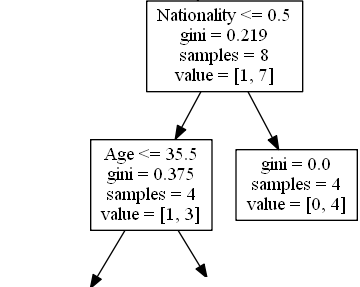
True - 4 Comedians Continue:
Age
Age <= 35.5 means that comedians
at the age of 35.5 or younger will follow the arrow to the left, and the rest will follow the arrow to the
right.
gini = 0.375 means that about 37,5% of the
samples would go in one direction.
samples = 4 means that there are 4 comedians
left in this branch (4 comedians from the UK).
value = [1, 3] means that of these 4
comedians, 1 will get a "NO" and 3 will get a "GO".
False - 4 Comedians End Here:
gini = 0.0 means all of the samples got the
same result.
samples = 4 means that there are 4 comedians
left in this branch (4 comedians not from the UK).
value = [0, 4] means that of these 4
comedians, 0 will get a "NO" and 4 will get a "GO".
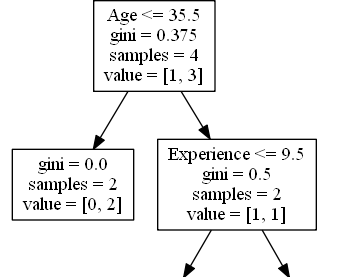
True - 2 Comedians End Here:
gini = 0.0 means all of the samples got the
same result.
samples = 2 means that there are 2 comedians
left in this branch (2 comedians at the age 35.5 or younger).
value = [0, 2] means that of these 2
comedians, 0 will get a "NO" and 2 will get a "GO".
False - 2 Comedians Continue:
Experience
Experience <= 9.5 means that comedians
with 9.5 years of experience, or less, will follow the arrow to the left, and the rest will follow the arrow to the
right.
gini = 0.5 means that 50% of the samples
would go in one direction.
samples = 2 means that there are 2 comedians
left in this branch (2 comedians older than 35.5).
value = [1, 1] means that of these 2
comedians, 1 will get a "NO" and 1 will get a "GO".
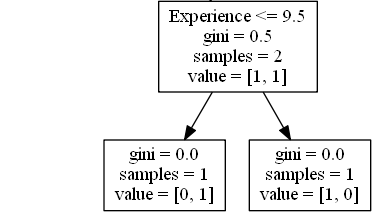
True - 1 Comedian Ends Here:
gini = 0.0 means all of the samples got the
same result.
samples = 1 means that there is 1 comedian
left in this branch (1 comedian with 9.5 years of experience or less).
value = [0, 1] means that 0 will get a "NO" and
1 will get a "GO".
False - 1 Comedian Ends Here:
gini = 0.0 means all of the samples got the
same result.
samples = 1 means that there is 1 comedians
left in this branch (1 comedian with more than 9.5 years of experience).
value = [1, 0] means that 1 will get a "NO" and
0 will get a "GO".
Predict Values
We can use the Decision Tree to predict new values.
Example: Should I go see a show starring a 40 years old American comedian, with 10 years of experience, and a comedy ranking of 7?
Example
Use predict() method to predict new values:
print(dtree.predict([[40, 10, 7, 1]]))
Example
What would the answer be if the comedy rank was 6?
print(dtree.predict([[40, 10, 6, 1]]))
Different Results
You will see that the Decision Tree gives you different results if you run it enough times, even if you feed it with the same data.
That is because the Decision Tree does not give us a 100% certain answer. It is based on the probability of an outcome, and the answer will vary.

